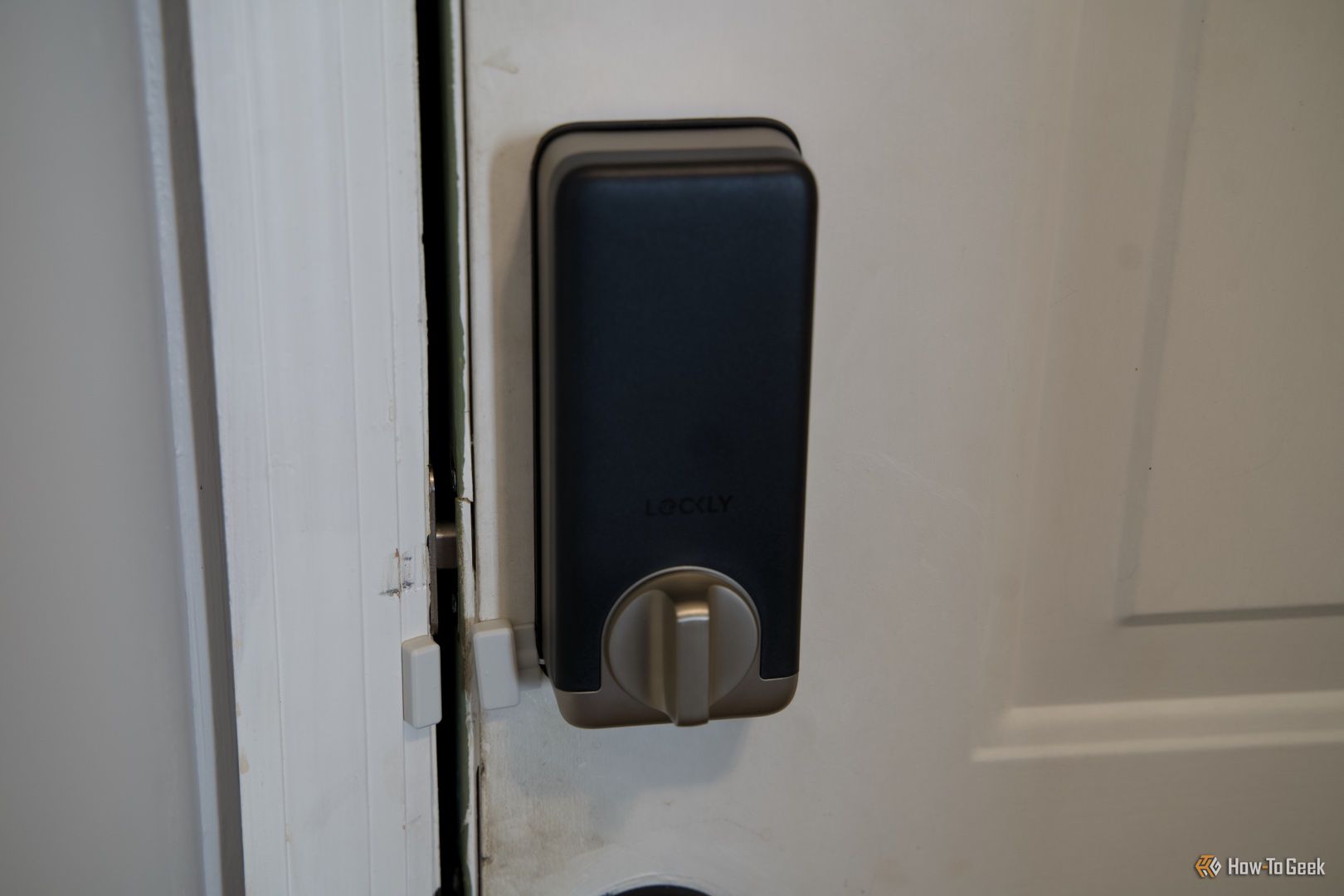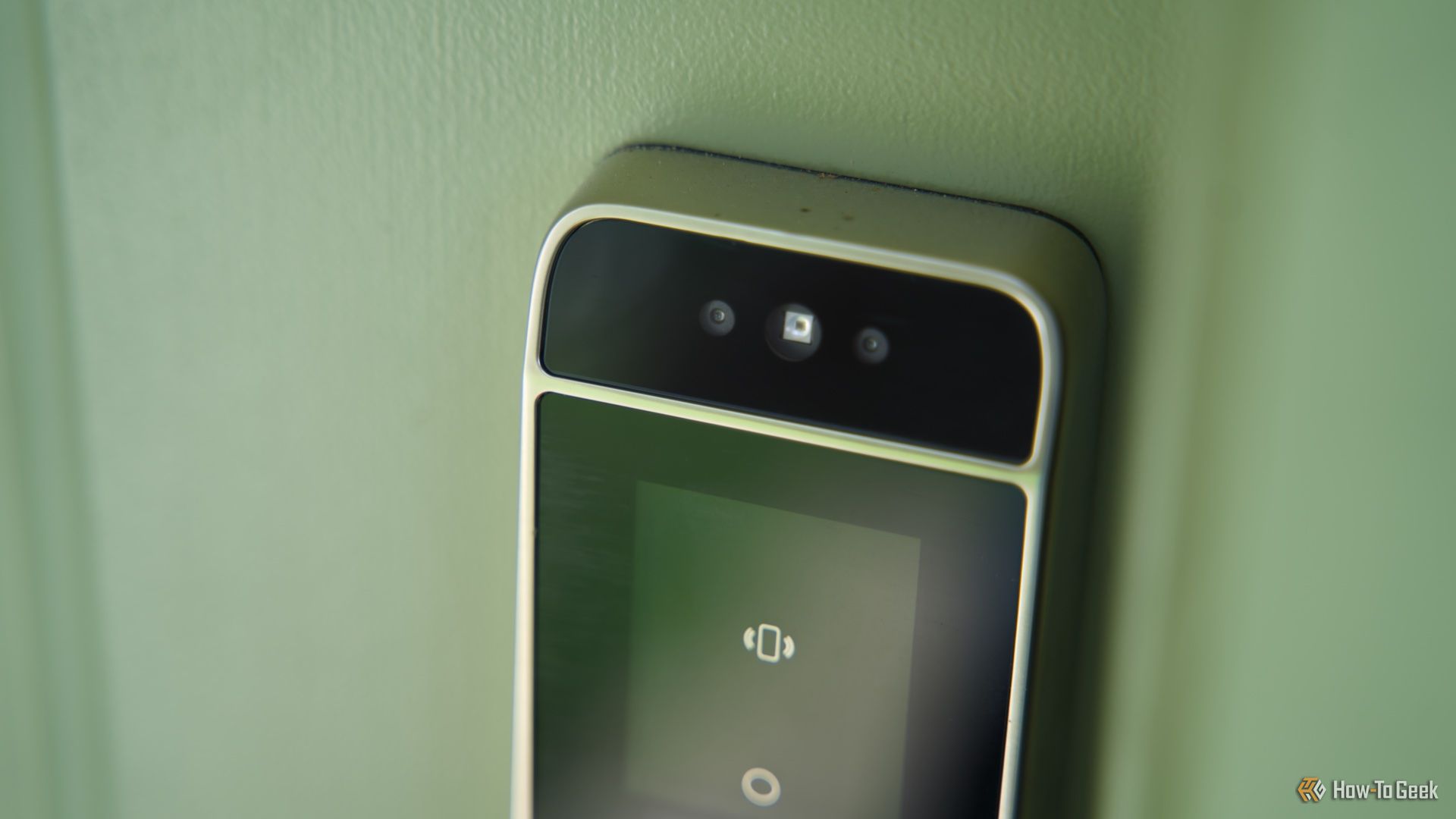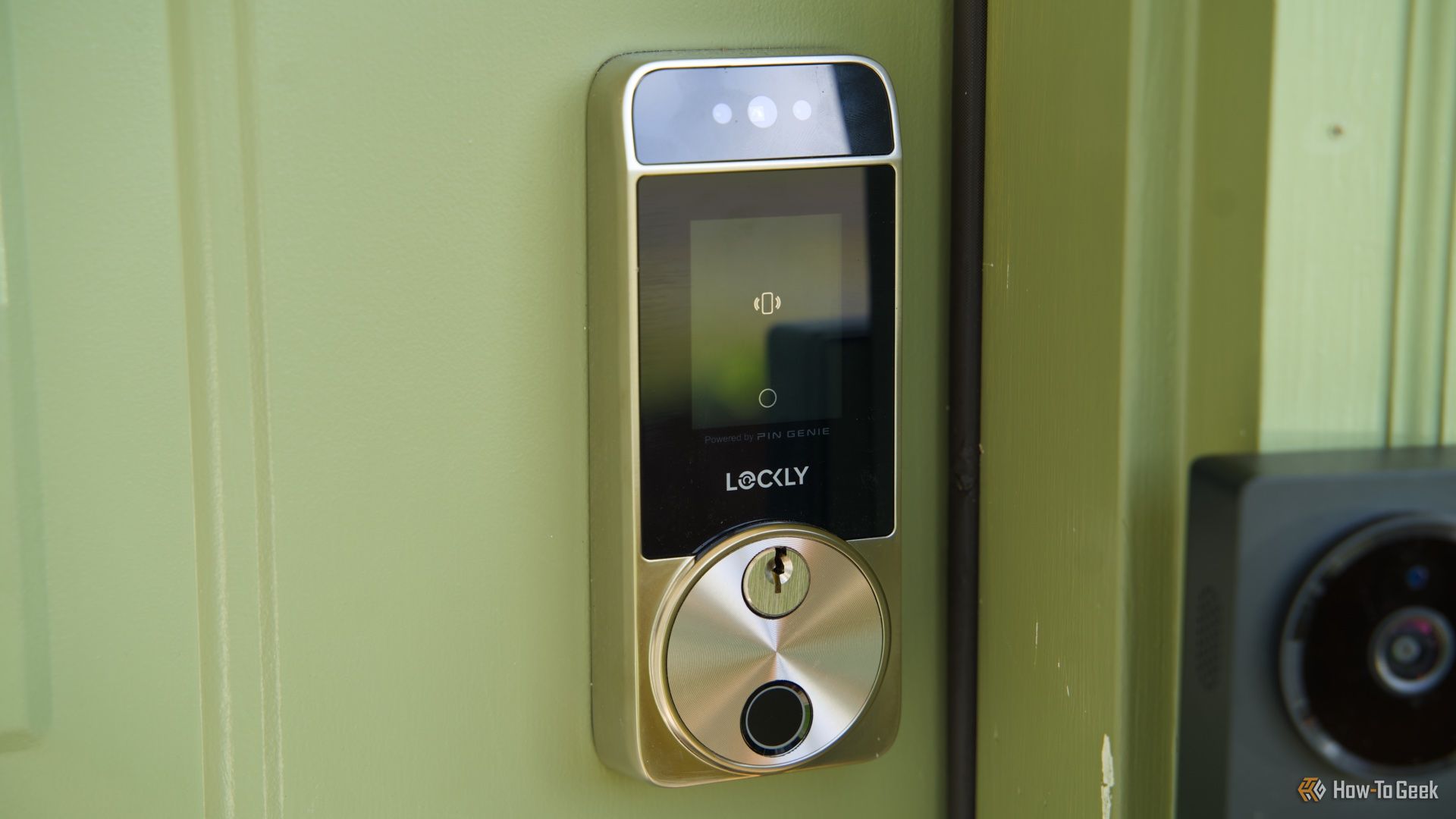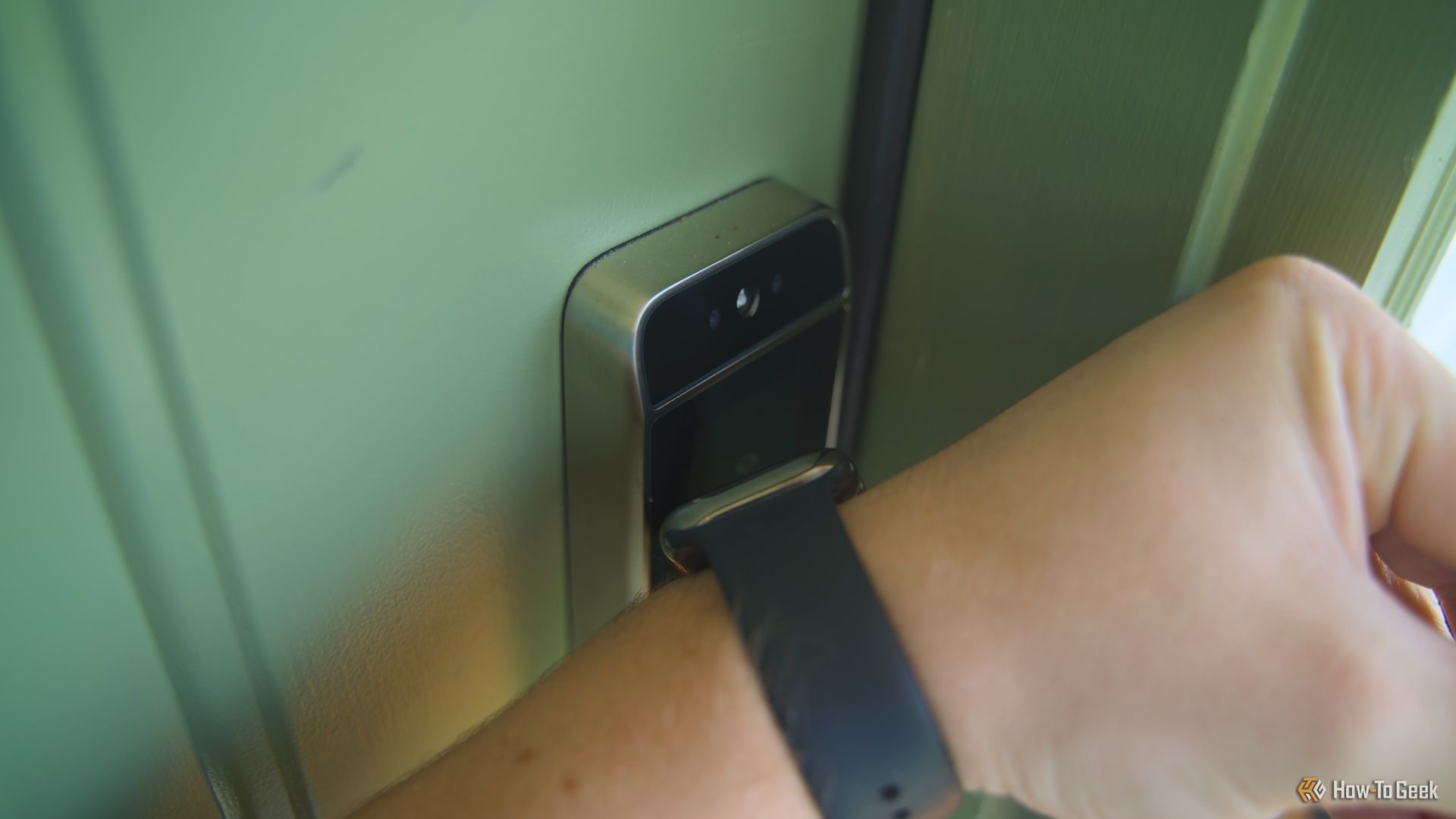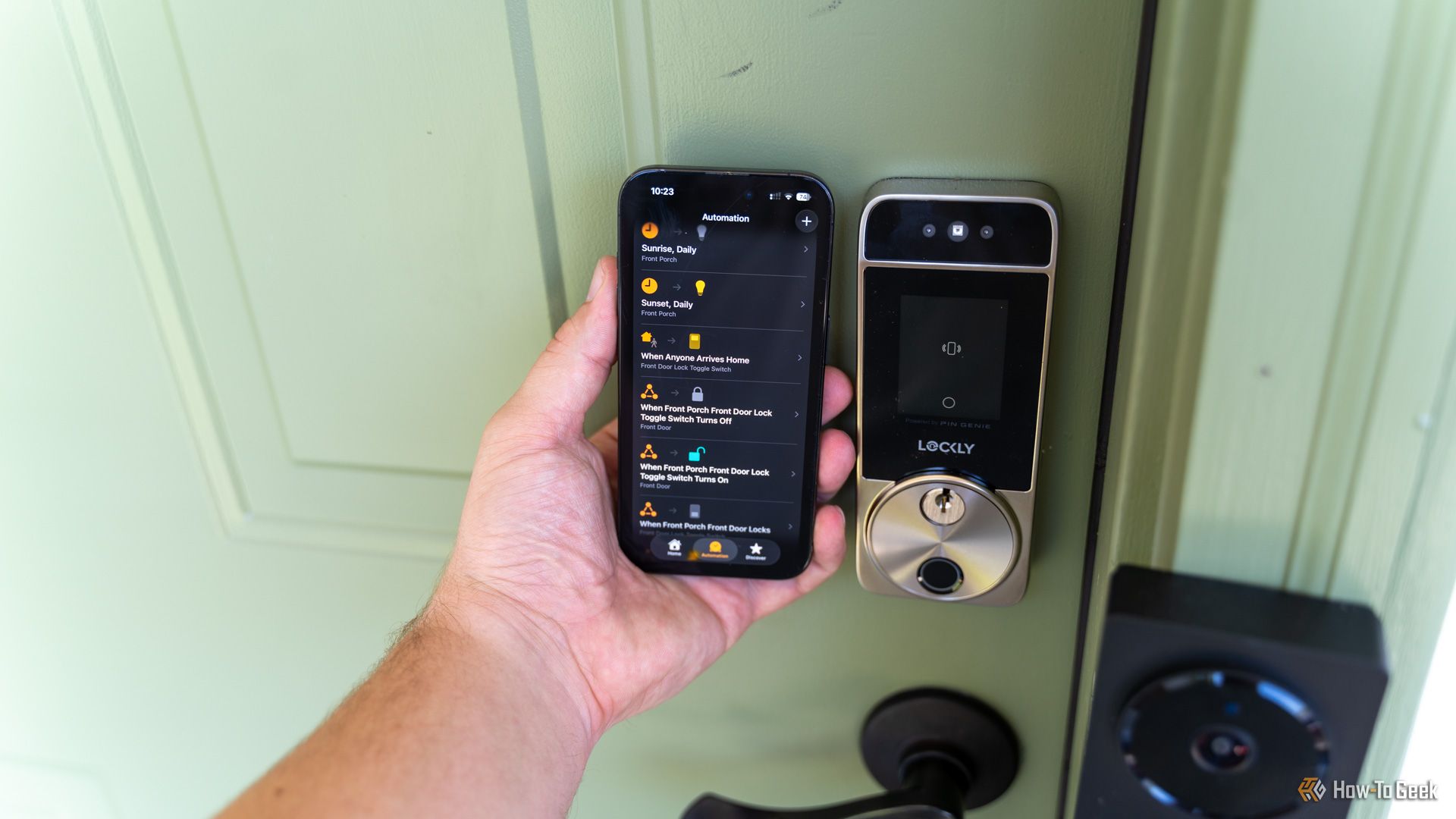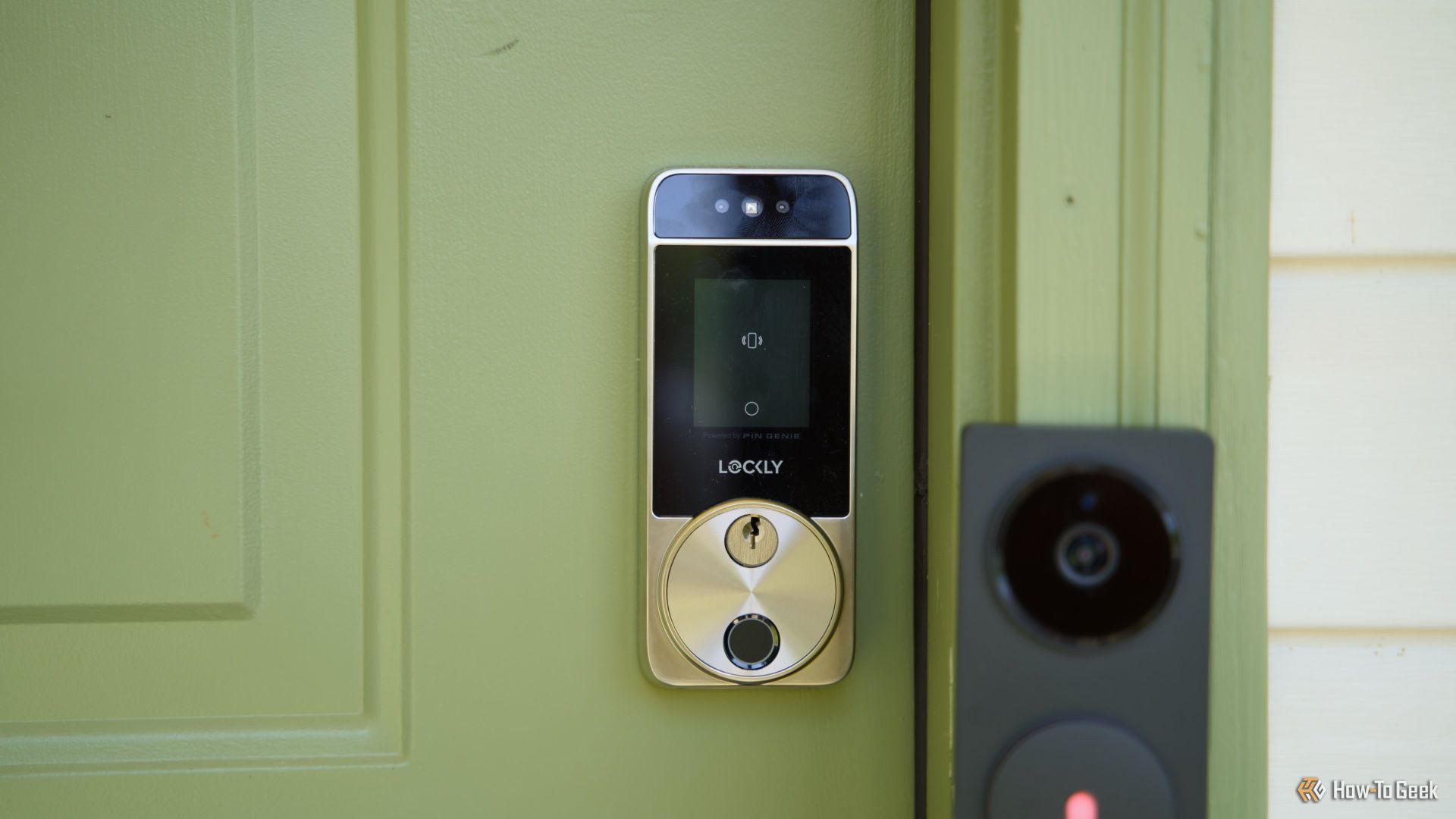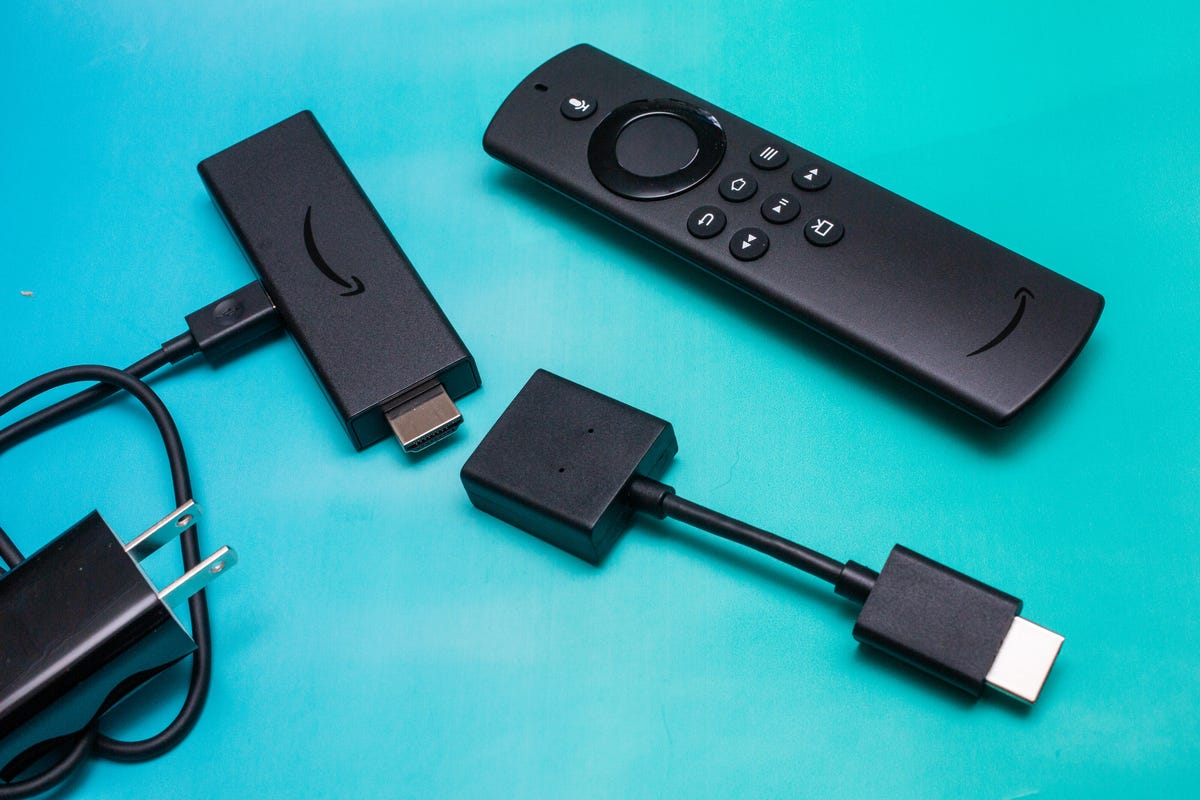A Smart Lock With Premium Features and a Price to Match
Smart locks have come a long way. We went from using keys only to enter our houses to PIN codes, fingerprints, voice controls, and even tapping our smartwatches. Lockly took home security to the next level with its $349 Visage smart lock, though, using an image of your face to unlock your door—and I’m mostly impressed.
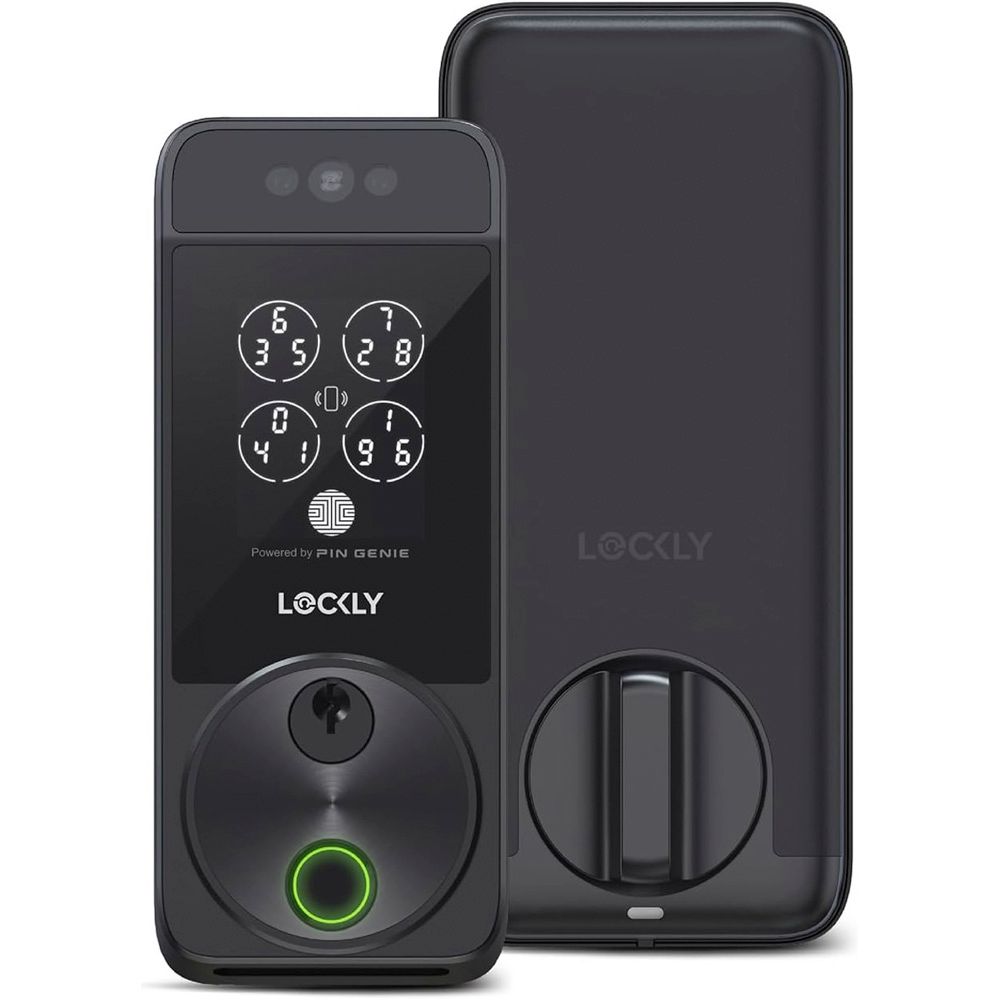
- Brand
-
Lockly
- Connectivity
-
Wi-Fi
- Integrations
-
HomeKit, Alexa, Google Assistant
- Battery
-
Two rechargeable batteries included
The Lockly Visage smart lock is a unique piece of smart home gear as it delivers multiple ways to unlock your door. From Apple HomeKit and HomeKey support to an auto-rotating PIN keypad for enhanced privacy, the Lockly Visage is a great addition to any smart home. It’s also an industry-first smart lock with facial recognition technology, automatically unlocking for faces that you program into it.
- Apple Home Key compatible
- Industry-first facial recognition unlock
- Ultra-reliable
- Easy to install
- HomeKit, Alexa, and Assistant compatible for voice control
- No way to disable auto-rotating PIN keys
- Still not 100% secure with using facial unlocking for front door
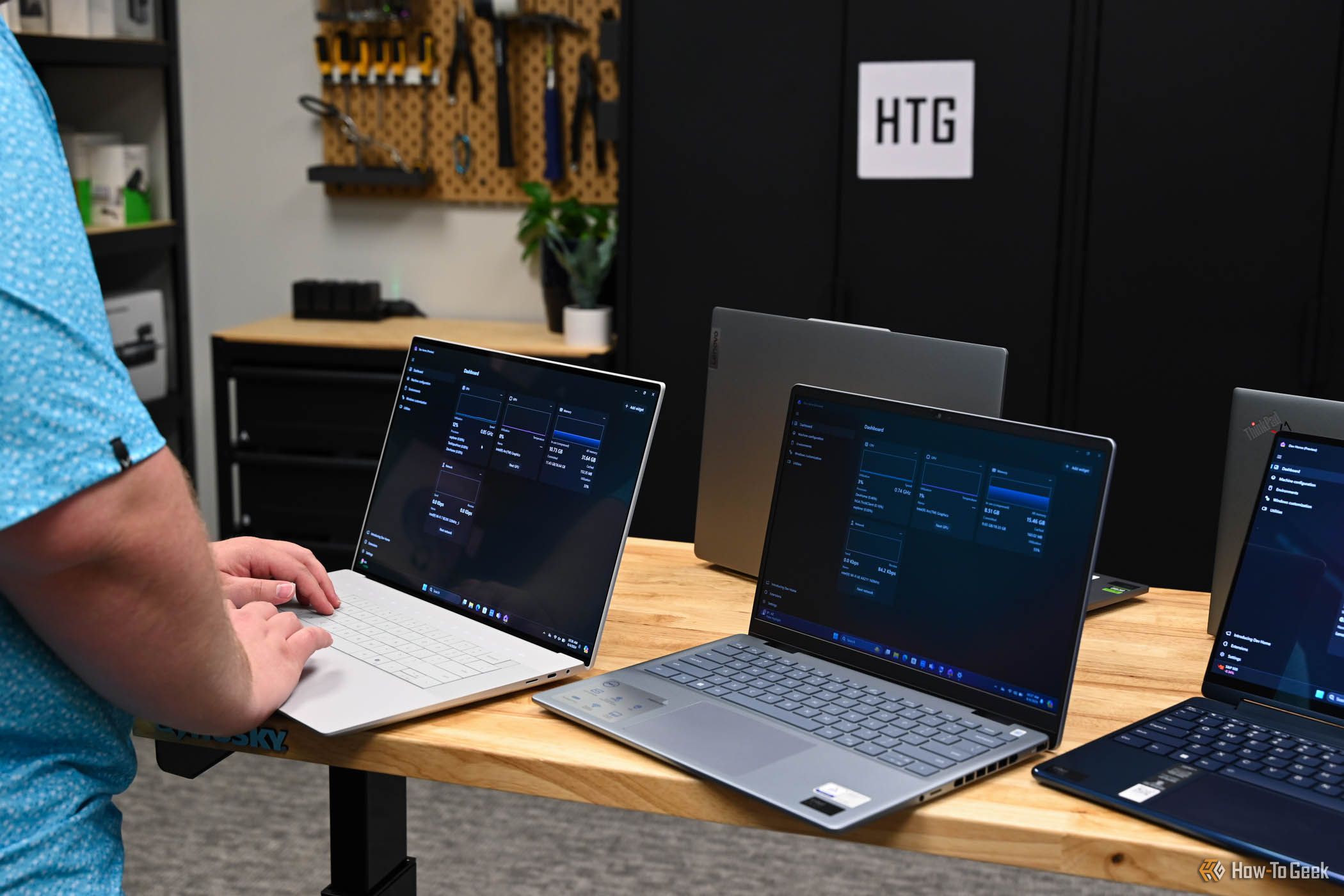
See Our Process
How We Test and Review Products at How-To Geek
We go hands-on with every product to ensure it’s worth your time and money.
Price and Availability
The Lockly Visage smart lock comes in Satin Nickel or Matte Black and goes for $349 from Lockly directly, as well as Amazon, Home Depot, or Best Buy.
- Brand
-
Lockly
- Connectivity
-
Wi-Fi
- Integrations
-
HomeKit, Alexa, Google Assistant
- Battery
-
Two rechargeable batteries included
- Keypad
-
Yes (Auto Rotating)
- Hub Required
-
No
This Lock Doesn’t Auto Lock With Your Door Open
I’ve used smart locks for five years at this point, and there’s one thing that always irks me with them: auto locking. You see, all the smart locks that I’ve had previously would auto-lock after a certain time, whether the door was open or not. I’ve even had smart locks that had door sensors, and they would say if the door was open or not—but the sensor had no effect on the auto lock.
Lockly’s Visage is different. The door sensor is built into the lock, and I highly recommend you set it up. I was on the fence at first because it’s in a strange place (right under the lock), and there wasn’t any information in the instructions that said what it did outside of working with the smart home integrations.
Well, I’m here to tell you that the door sensor prevents the lock from auto-locking while the door is open—99% of the time. There have been one or two times when the door has still auto-locked with the door open, but it was typically because I opened the door again right as the auto-lock timer was up, and it started to lock. The Lockly app would then fire a notification and tell me that the door was locked while the door was open, which is a nice touch.
I’m Still Not Sure if I Trust Facial Recognition Unlock
I recently reviewed a palm scanning smart lock, and I’m pretty confident in its ability to distinguish my hand from another—we’ve been doing fingerprints for years, and palms are just as unique.
When it comes to facial recognition, I’m a bit more hesitant. I’ve got facial recognition running on my NVR and my other cameras around the house, and the accuracy has always been so-so. Facial recognition in photos apps like Google Photos or iCloud Photos is equally unreliable for me. Great sometimes, and other times it equates a dog with my face. No comment.
I know that Face ID and other facial recognition technologies on phones are different, using LiDAR mapping to make a unique print of your face. But, Lockly doesn’t mention LiDAR anywhere in its marketing kit. In fact, the only thing it talks about is “dual infrared sensors” that let it work day or night.
Meanwhile, the fingerprint sensor is touted as a “3D biometric fingerprint sensor with embedded AI learning,” giving me quite a bit of confidence there.
I tried out the facial recognition, and it was very accurate for me, and never unlocked when someone else walked up to the door, but I just don’t know about leaving it enabled long-term. That’s just my opinion, though, as I’ve had too many false-positives for other facial recognition tech in my life to fully trust it with access to my home.
HomeKey Is the Best Selling Point
I’ll be honest, one of my favorite things that the Lockly Visage offers is both HomeKit and Home Key integration. I’ve had HomeKit smart locks in the past, but this is my first Home Key one—and I’m never going back.
Let me break down why HomeKit and Home Key integrations are so great here. For starters, Home Key locks are quite rare. Yes, the Lockly Visage works with all smart home platforms, and not just Apple’s, but Home Key allows you to use your Apple Watch or iPhone to unlock your door by simply tapping.
Essentially, with Home Key, you can have a saved Express Mode key in your Apple Wallet that will unlock the door whenever you touch your iPhone or Apple Watch to the lock. Now, if auto-unlocking fails or doesn’t trigger for any reason, I can just tap my Apple Watch or iPhone to unlock the door.
This is great as I can be carrying groceries up to the house with my hands full, and I just need to tap my wrist to the door to unlock. I’ve had NFC-unlocking doors in the past, but they always required a secondary key card. The Lockly Visage just requires a compatible Apple Watch.
Home Key alone is enough for me to love this smart lock, but with the HomeKit integration that comes side-by-side with Home Key, I was able to fully automate unlocking when I come home.
While Lockly’s app doesn’t offer geo-fence unlocking (something I think all smart locks should have so your home can welcome you back when you arrive), it’s pretty easy to work around. I have a full write-up of how I did it, but essentially I used HomeKit automations to unlock the front door when I arrive home.
This means that I don’t even have to use my Apple Watch to unlock the door when I arrive home. However, if the door auto locks before I can get up to it, or if I’m going back and forth from the house to the car with the door shut and it auto locks, then I can just tap my wrist and gain entry easily—no PIN necessary.
The Always-Changing PIN Code Is Annoying, but Secure
I love how easy it is for me to unlock the Lockly Visage with my Apple Watch (or my HomeKit automations). However, I’m not a fan of how the PIN code works on this smart lock.
I’ve used many smart locks in the past, and PIN codes are a staple of even non-connected locks. Something that I’ve always relied on in the past is pattern recognition for myself to unlock my front door. My door is placed in a way that people can’t really see my lock when I enter a PIN code, so, for my own personal code, I use a specific pattern.
The pattern itself has changed from lock to lock as the button layouts are always a bit different, but fixed layouts allow for fixed patterns. The Lockly Visage, however, does not offer a fixed button layout.
The buttons on the display are ever-changing. By default, the buttons shuffle each time the screen turns on. This means that you have to look to see where the buttons are located each time you enter the PIN.
There’s another method that is even more secure, though—the buttons change location with each press. I totally get why Lockly has this happen (either method). It’s way more secure than fixed-position keys, and makes it much harder for people to guess your passcode.
For me, however, that’s not a problem I have, and it just makes the lock that much harder to use if I’m not using the smart functions of it.
What I’d love to see is a toggle to disable this rotating PIN code. Allow me, the user, to determine which level of security I need. Fixed PIN code buttons, rotating every time the lock screen turns on, or rotating with each key press. Letting me choose that puts me in the driver’s seat of how secure the lock is.
A six-digit PIN code is already quite secure, especially when it’s rarely used, thanks to the smart functions of this lock. Letting me disable the rotating PIN screen is the least Lockly could do.
Should You Buy the Lockly Visage Smart Lock?
The Lockly Visage is in a unique position. The Lockly Visage slots into an ultra-premium price bracket for a smart lock at $349, making it more expensive than most of the competition. This is justified, given the feature set—especially as the Visage is an industry-first smart lock with facial recognition unlocking.
I think it really comes down to whether or not you’ll leverage the facial recognition functionality here. If you don’t plan to use it, then the Lockly Visage is a bit too expensive for my taste, especially as you can pick up other Home Key-enabled smart locks without the rotating PIN code for about 50% less.
However, if you want to be on the bleeding edge and have your door unlock when you walk up to it using nothing but your face, then the Lockly Visage is a great smart lock that’s feature-packed, reliable, and sleek—and it’s the only one that’s up to the task.

- Brand
-
Lockly
- Connectivity
-
Wi-Fi
- Integrations
-
HomeKit, Alexa, Google Assistant
- Battery
-
Two rechargeable batteries included
The Lockly Visage smart lock is a unique piece of smart home gear as it delivers multiple ways to unlock your door. From Apple HomeKit and HomeKey support to an auto-rotating PIN keypad for enhanced privacy, the Lockly Visage is a great addition to any smart home. It’s also an industry-first smart lock with facial recognition technology, automatically unlocking for faces that you program into it.


